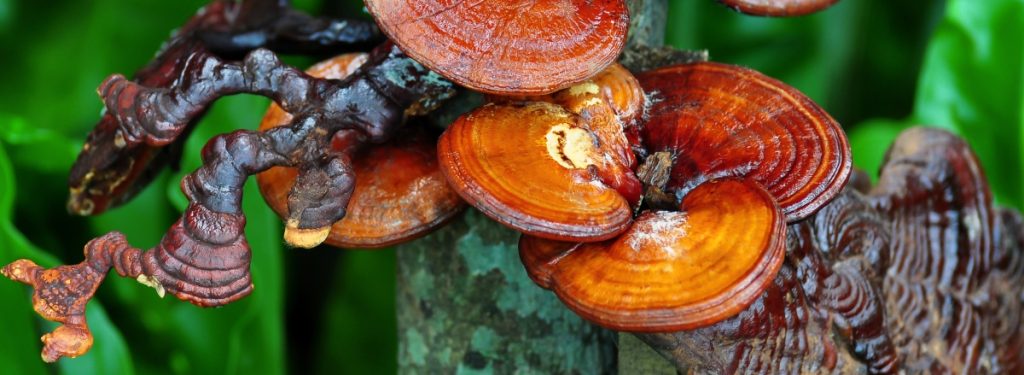LIf you are looking for a medicinal mushroom species to grow at home, reishi mushrooms are a good choice.
Reishi is known for its medicinal properties and is relatively easy and intriguing to grow. It also produces beautiful fruiting bodies.
What’s more, you don’t need expensive equipment or specialized grow rooms to grow reishi mushrooms. And, there are several different methods you can use to grow them.
In this guide, you’ll learn more about reishi mushrooms and the easiest ways to grow them both indoors and outdoors. If you’re in the UK you can also check out our MycoTonics range which includes the amazing reishi mushroom.
What Are Reishi Mushrooms?
Reishi mushrooms (Ganoderma lucidum) are saprotrophic bracket or shelf fungi that feed on dead or dying hardwood stumps and trees.
There are around 80 different species of Ganoderma lucidum worldwide, and they have several different names. In the west, reishi is the most popular name, but there are many others.
In the east, where people have used these mushrooms for more than 2000 years, they also have several names. The most common being lingzhi or the mushroom of immortality.
What Do Reishi Mushrooms Look Like?
Reishi is a shelf fungus that grows horizontally out of the trunks of trees and stumps.
Initially, reishi develops as slender finger-like stalks called antlers. These are deep red to rust-brown in color with yellow, tan and white at the growing tip.
Mature reishi flattens out into a fan shape and has a shiny, deep red body that lightens to orange, yellow and white toward the edge of the cap.
Underneath the cap, they’re yellow with pores instead of gills, from which they release brown spores.
Young reishi mushrooms have a wet lacquered look. As they age, the cap tends to fade and become a dull brownish color.
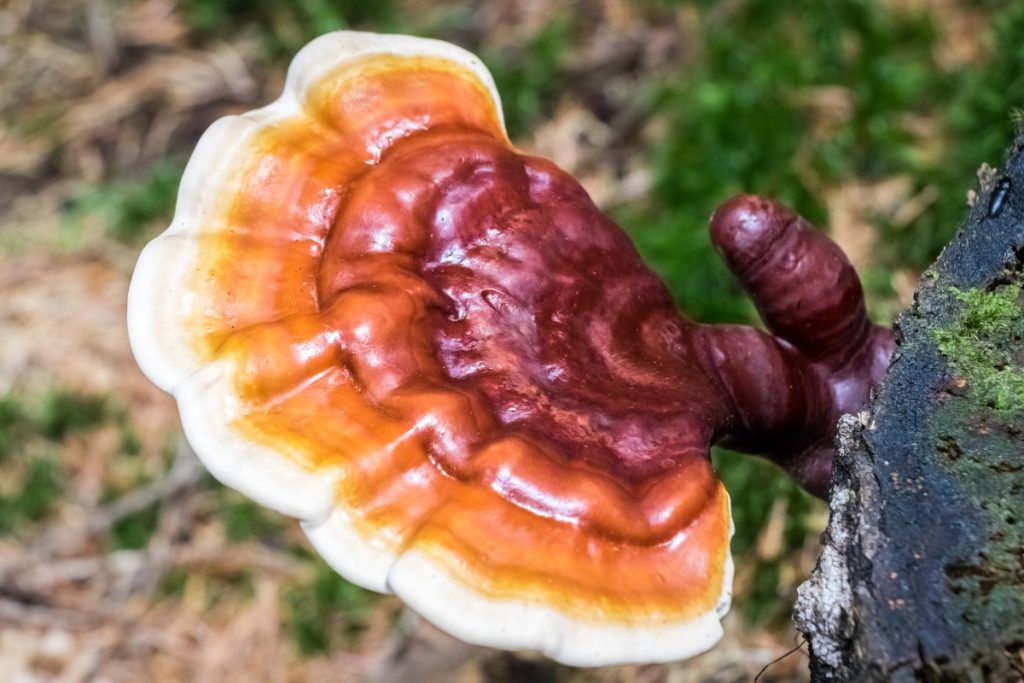
What Do Reishi Mushrooms Taste Like?
Reishi mushrooms don’t taste good and have a tough woody texture. People who try them describe them as being bitter and a bit like eating tree bark.
But, the taste is not the reason people consume reishi. It’s the host of medicinal benefits that make this mushroom so popular.
Our complete guide to reishi mushrooms has more information on the different types of reishi mushrooms, where to find them and how to prepare them for use.

Where Do Reishi Mushrooms Grow?
You can find wild reishi mushrooms worldwide in several different climates. Some species prefer cooler temperatures, while others enjoy tropical climates.
Most reishi prefers to grow on dead and dying hardwood trees like oak, elm, beech and maple. But, some species prefer conifers, particularly hemlock.
Reishi mushrooms tend to grow closer to the ground at the base of trees or stumps. Any bracket fungi that you find higher up on trees are probably not reishi.
Summer to fall is the best time to find reishi in the wild. But, you could find older reishi on trees all year-round.
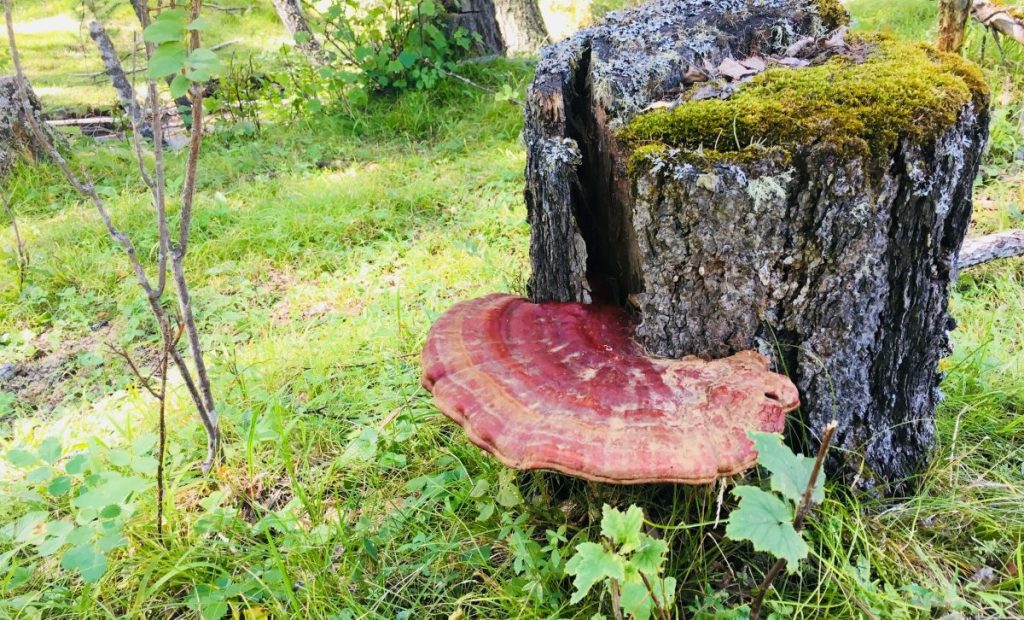
Why Grow Reishi Mushrooms?
If your location does not allow you to forage for reishi mushrooms, but you want all the fantastic health benefits they offer. Growing them yourself is a great option.
There are several reasons why you should grow reishi, including:
-
- You don’t need expensive equipment.
-
- You don’t need perfect grow room conditions.
-
- You can grow reishi indoors or outdoors.
-
- You can grow reishi in jars, buckets or bags and on logs.
-
- They colonize substrates quickly.
-
- They’re resistant to infections and contaminants.
-
- They can tolerate both high and low levels of CO2.
-
- They’re fascinating to watch as they mature and develop.
-
- You can grow them in two different forms, the conk form or the antler form.
-
- They’re beautiful mushrooms to grow.
-
- They have numerous health benefits.
Read our article, “Reishi Mushroom Benefits and How to Get Them,” to learn more about the medicinal benefits of reishi mushrooms.
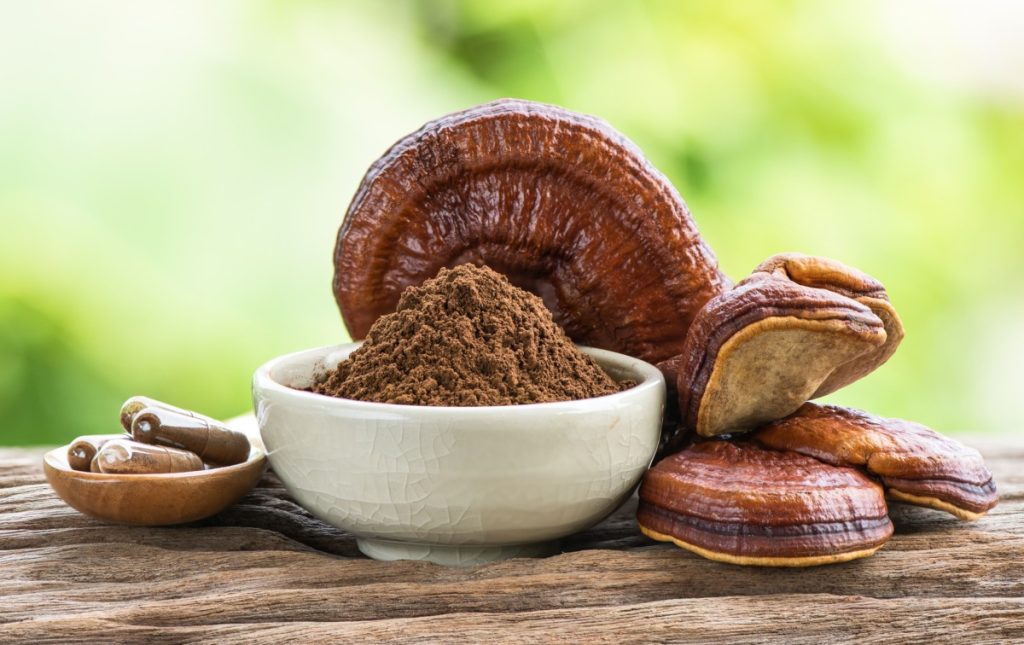
Can You Grow Reishi Mushrooms at Home?
Yes, you can grow reishi mushrooms at home, and they’re one of the easiest medicinal mushrooms to grow.
Although not as easy as growing oyster mushrooms, growing reishi mushrooms is not complicated. And, you don’t need a lot of previous experience to get started.
If you’re a complete beginner, you may be wondering, “How do you grow reishi?”
The easiest way to grow reishi is to use a reishi grow kit. You can buy these online from a supplier in your area.
Grow kits come with an inoculated and colonized substrate block, meaning you can start the fruiting process as soon as you get your grow kit.
Before long, you’ll be the proud owner of your very own homegrown reishi mushrooms.
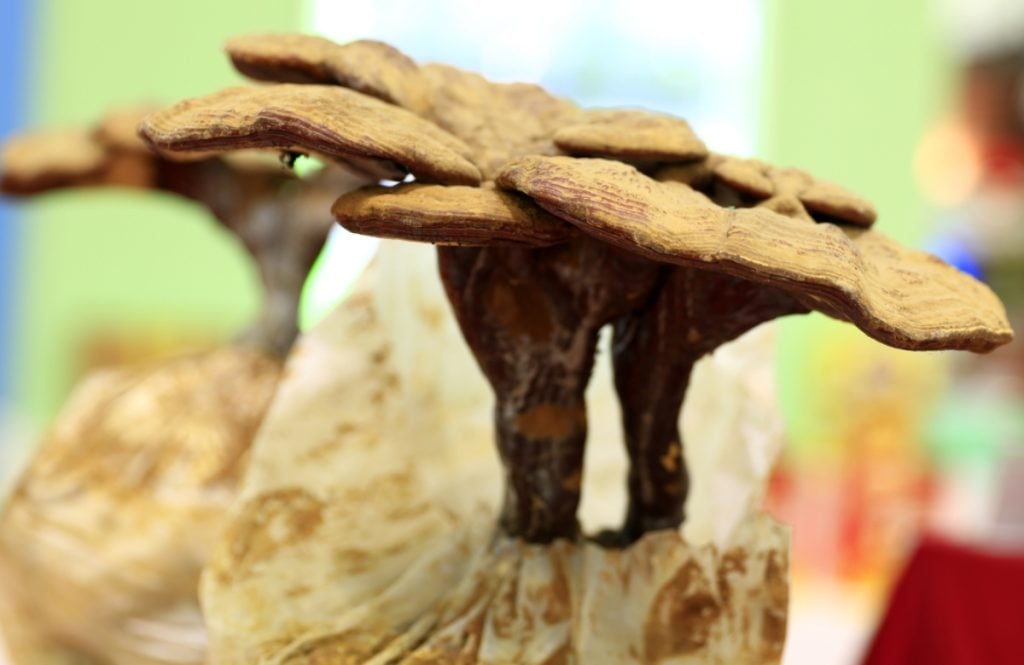
How Long Does it Take to Grow Reishi Mushrooms?
How and where you grow reishi mushrooms dictates how long they take to grow.
Growing reishi mushrooms on logs takes longer than if they are grown in bags or containers.
Try growing reishi using a block of supplemented sawdust, indoors or outdoors. You could be harvesting fresh reishi around eight weeks from the time you inoculate the substrate.
Fruiting is the longest stage, and it can take up to six weeks for reishi mushrooms to reach maturity from the time pins first appear.
But, colonization is relatively quick. It usually takes the mycelium 7 to 14 days to fully colonize a sawdust block.
However, if you choose to grow reishi on logs, colonization takes a lot longer.
When using sawdust spawn to inoculate logs, it takes 9 to 12 months before your reishi begins to fruit.
And, if you inoculate logs with plug spawn, it can take 15 to 18 months before you see signs of reishi mushrooms.
Additionally, the larger the diameter of your logs, the longer colonization takes.
Temperature and growing conditions also play a role in how long it takes to grow reishi.
Cooler temperatures may slow down the process.
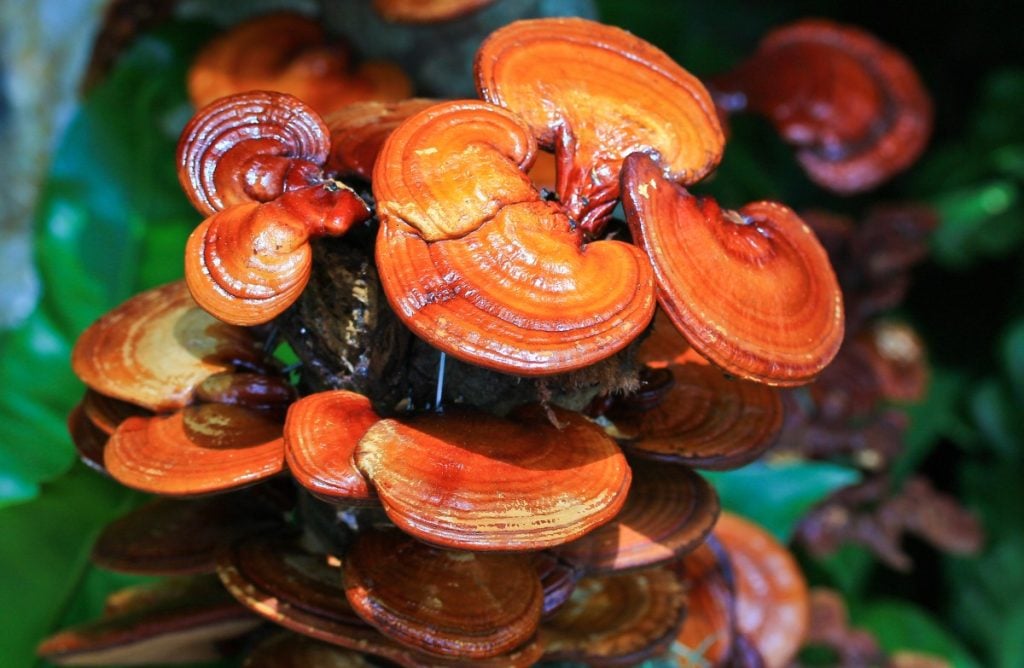
Reishi Mushroom Substrates
The goal of a mushroom substrate is to provide a moist, nutrient-dense food source for the fungi’s mycelium.
Reishi mushrooms are selective about what they eat. Unlike oyster mushrooms, which grow on almost anything, including coffee grounds and cardboard.
Reishi mushrooms prefer a hardwood growing medium, so you’ll need to grow them on logs or blocks of hardwood sawdust.
When growing reishi mushrooms in bags or containers, supplemented hardwood pellets or sawdust work well and, if you can get it, oak is best.
We like to add oat or wheat bran to the hardwood pellets to provide extra nutrients for the mycelium.
Some growers add gypsum and calcium carbonate to the substrate mixture for even higher yields, but this is optional.
If you choose to grow reishi on logs, you can use a wide range of trees to source them. Sugar maple, sweetgum, red maple, silver maple, or oak are ideal for most species of reishi.
But, Ganoderma tsugae, a reishi species commonly found in the Northeastern United States, prefers hemlock and other coniferous trees.
How to Grow Reishi Mushrooms Indoors
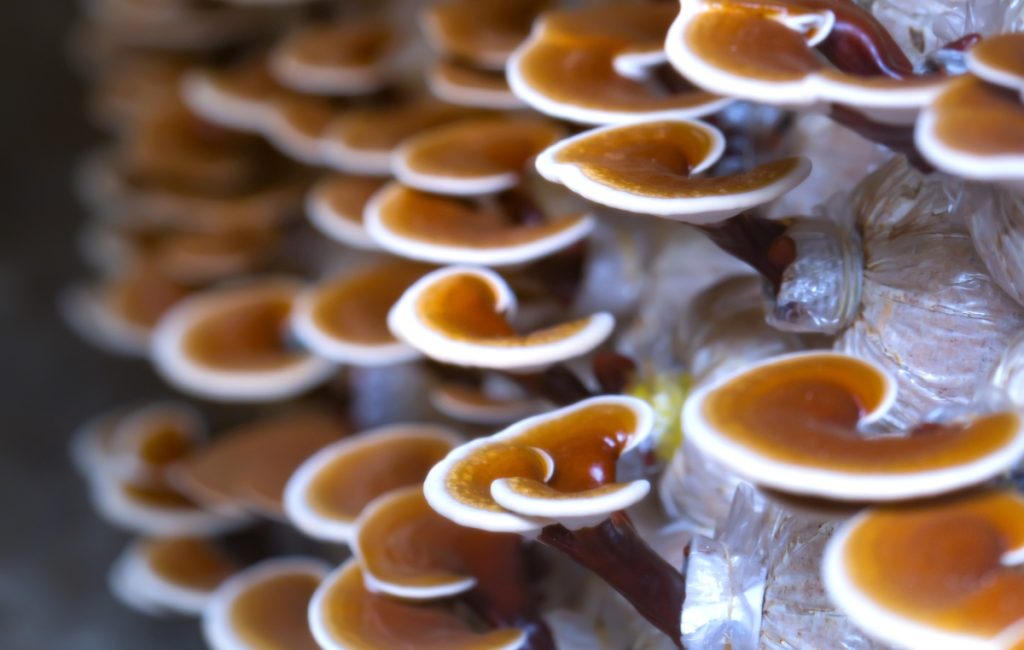
There are several ways you can go about growing reishi mushrooms indoors.
When deciding which method is best for you, consider your level of experience and how many mushrooms you would like to grow.
As mentioned before, a grow kit is a great way for complete beginners to quickly and successfully grow reishi mushrooms.
Or, if you want to understand more of the process, you can order reishi grain spawn and prepare and inoculate the substrate yourself.
An even bigger challenge is to start from scratch and grow your own reishi grain spawn. But, it’s best to try this once you have some experience.
Reishi mushrooms can tolerate both high and low levels of CO2, and you can grow them in a range of containers, including bags, buckets, jars and other recycled containers.
The step-by-step guide below is for new mushroom growers who want to make their own fruiting blocks, using reishi spawn purchased from a reputable supplier and mushroom grow bags.
Step 1: Gather Supplies
The first step when growing reishi mushrooms is to order and gather the supplies you’ll need, including:
-
- Reishi spawn – You can use grain or sawdust spawn when growing reishi mushrooms indoors.
We recommend grain spawn as it’s easier to break apart and mix with the substrate.
Reishi spawn holds sawdust together tightly, making sawdust spawn harder to break apart and spread evenly through the substrate.
- Reishi spawn – You can use grain or sawdust spawn when growing reishi mushrooms indoors.
-
- Hardwood pellets – These are an easy alternative to sawdust or wood chips. And readily available as people use them for pellet stoves and grills.
They’re also relatively inexpensive and easy to store. But, make sure you get hardwood pellets as reishi doesn’t grow on softwoods.
- Hardwood pellets – These are an easy alternative to sawdust or wood chips. And readily available as people use them for pellet stoves and grills.
-
- Oat or wheat bran – Bran is a nitrogen-rich supplement added to substrates to provide extra nutrients for the mycelium.
You can find small bags of bran at your local grocery store. But, if you plan on growing lots of mushrooms, a less expensive option is to buy larger quantities from animal feed stores.
- Oat or wheat bran – Bran is a nitrogen-rich supplement added to substrates to provide extra nutrients for the mycelium.
-
- Large grow bags – These bags are perfect for growing mushrooms indoors.
They have filter patches that allow the mycelium to breathe while it colonizes the substrate. And can withstand the temperatures required for sterilizing your substrate.
You can also use these bags as mini fruiting chambers. They have space for the reishi antlers to form on the top of the substrate while inside the closed grow bag.
- Large grow bags – These bags are perfect for growing mushrooms indoors.
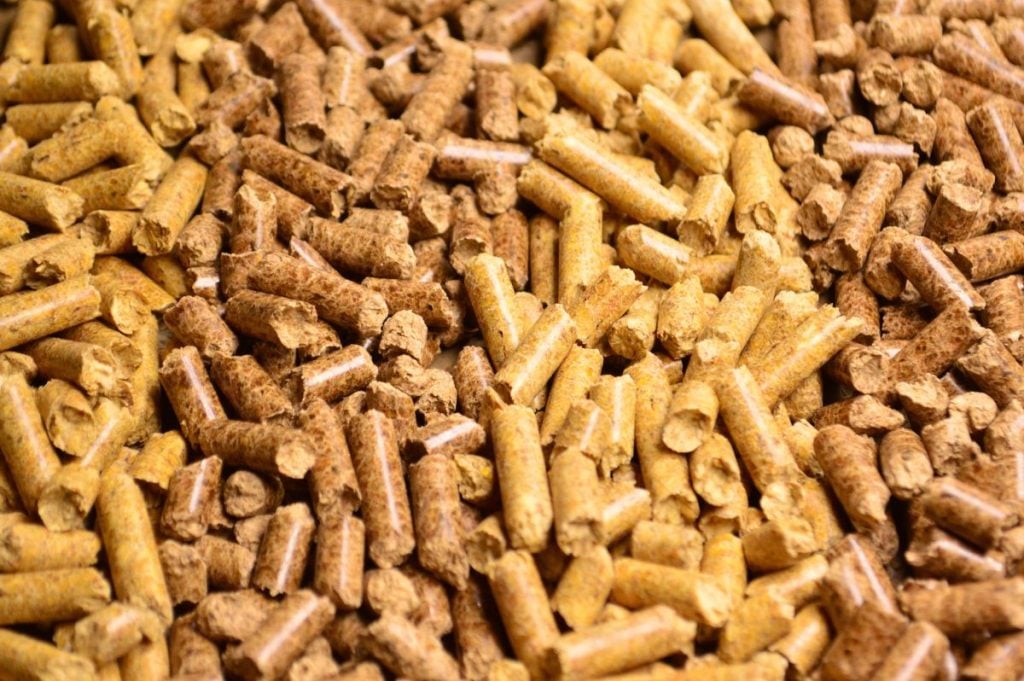
Step 2: Prepare Substrate
Once you have all your materials, you’re ready to begin. First, you’ll need to prepare your reishi growing medium or substrate.
A large grow bag usually makes a 5 lb (2.3 kg) fruiting block.
Ingredients
To make a 5 lb (2.3 kg) block of substrate, you need:
-
- Five cups of hardwood pellets
-
- One and a quarter cups of bran
-
- Six cups of water
Process
-
- Combine the pellets and water in a bucket or bowl and soak for 30 minutes. The hardwood pellets will break apart and become sawdust. Warm water will speed up the process but is not necessary.
-
- Add the bran to the sawdust and mix thoroughly until evenly distributed.
-
- Do a squeeze test to make sure your substrate has the correct moisture content. When you squeeze your substrate slightly, it should stay together in your hand, and only a couple of drops of water should come out.
-
- Place the mixture into your grow bag, expel as much air as possible and fold the bag according to instructions.
-
- Now place the bag in a pressure cooker and cook it for two and a half hours at 15PSI.
-
- Remove the bag from the pressure cooker and allow your substrate to cool. Once completely cool, this can take up to eight hours, move on to step three, inoculation.
Step 3: Inoculation
Inoculation is the process of mixing the reishi grain spawn into the prepared hardwood substrate.
Before you begin, wipe down all work surfaces and clean your hands well with soap to avoid contaminating the substrate.
Next, you need to add reishi grain spawn at a 5% spawn rate to the wet substrate and mix them together.
You can do this inside the bag, but it’s often easier to mix them outside the bag in a large box or container.
Once the substrate and spawn are well mixed, load the inoculated substrate into your grow bag.
Close the top of the bag with a rubber band, tape or a tie of some kind.
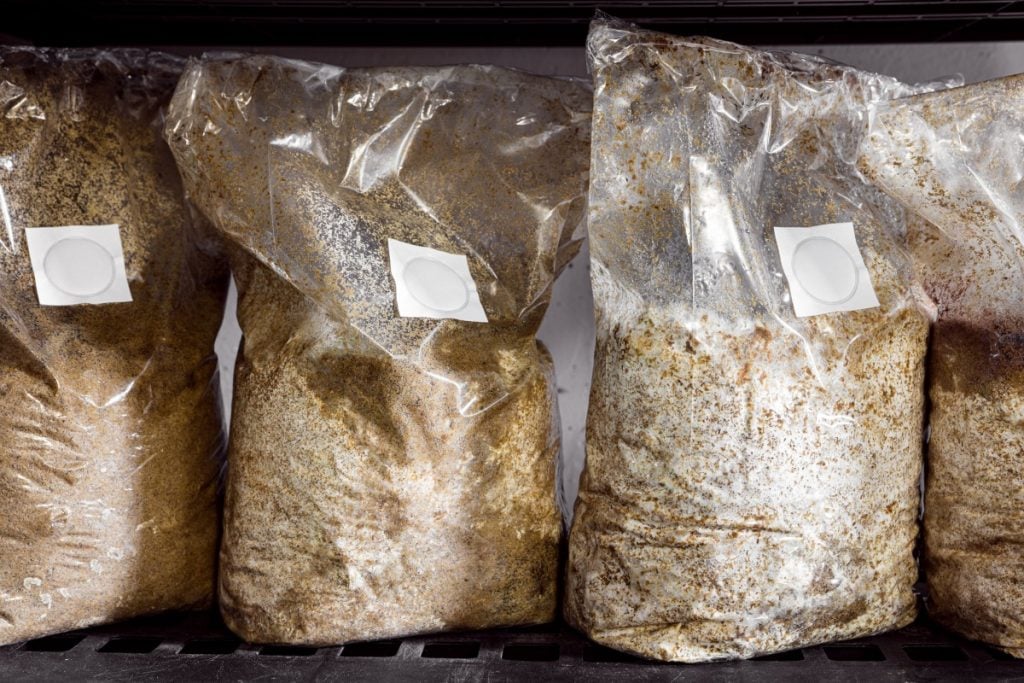
Step 4: Incubation
Place the closed grow bag in a warm, dark area at room temperature and leave it to incubate.
The reishi spawn will grow and spread throughout the bag until it completely colonizes the substrate.
Reishi is a strong colonizer and usually takes 10 to 14 days to colonize a bag of substrate.
But with optimal temperatures and 80 percent humidity, the reishi could colonize the block in a week.
Lower temperatures will slow the colonization process down.
Step 5: Fruiting
Once colonization is complete, you need to provide the right temperature and humidity, called fruiting conditions, for your reishi to fruit and produce mushrooms.
Reishi grows best at room temperature around 75-85 F (24 – 29C) but tolerates a wide range of temperatures, and cooler temperatures around 65F (18C) can help initiate pinning.
Like other mushrooms, reishi needs high humidity to grow best. They do well with humidity levels of 85 to 90 percent.
When reishi mushrooms first appear, they produce finger-like projections called antlers that look like candy corn because of their color.
At this stage, growing reishi mushrooms gets interesting. You can grow these mushrooms in the form of antlers or conks, depending on your preference.
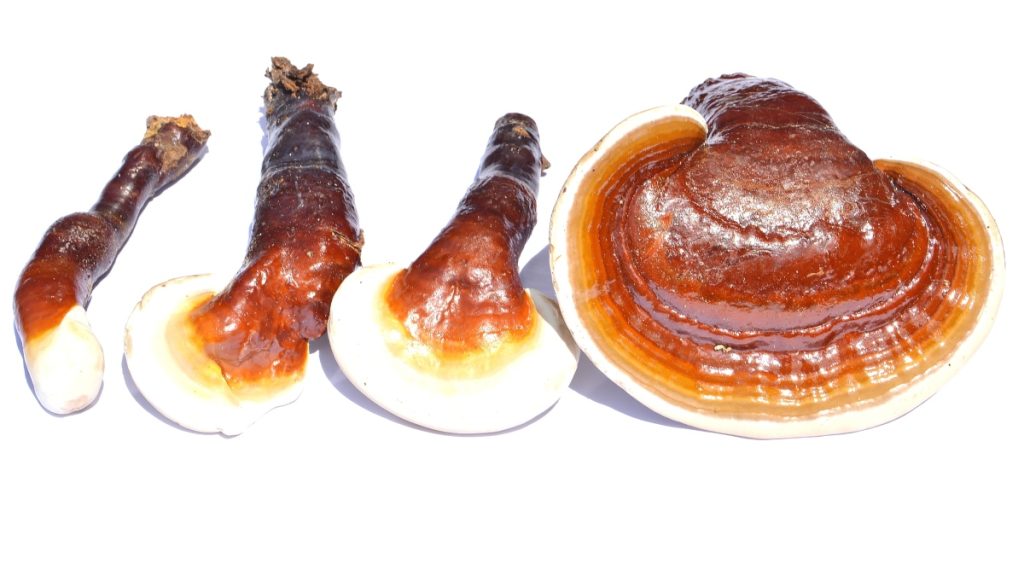
Growing Antler Reishi Mushrooms
Antler reishi mushrooms often begin to grow inside the bag as soon as colonization is complete as they can tolerate an environment high in CO2.
Growing reishi mushrooms in the antler form doesn’t give as high a yield as the conk form.
But it’s easy and takes almost no work because you can grow antler reishi mushrooms inside your CO2-rich grow bag.
The bag acts as a mini-greenhouse, keeping in humidity and maintaining the temperature.
To grow antler reishi, place your fully colonized grow bag in a spot with indirect light and temperatures of around 65 -75 F (18 – 24C).
Now you can sit back and watch as the reishi antlers slowly grow and form interesting shapes.
When they reach the top of the bag, the antlers will sometimes grow through the filter patch or twirl back on themselves, creating unique sculpture-like formations.
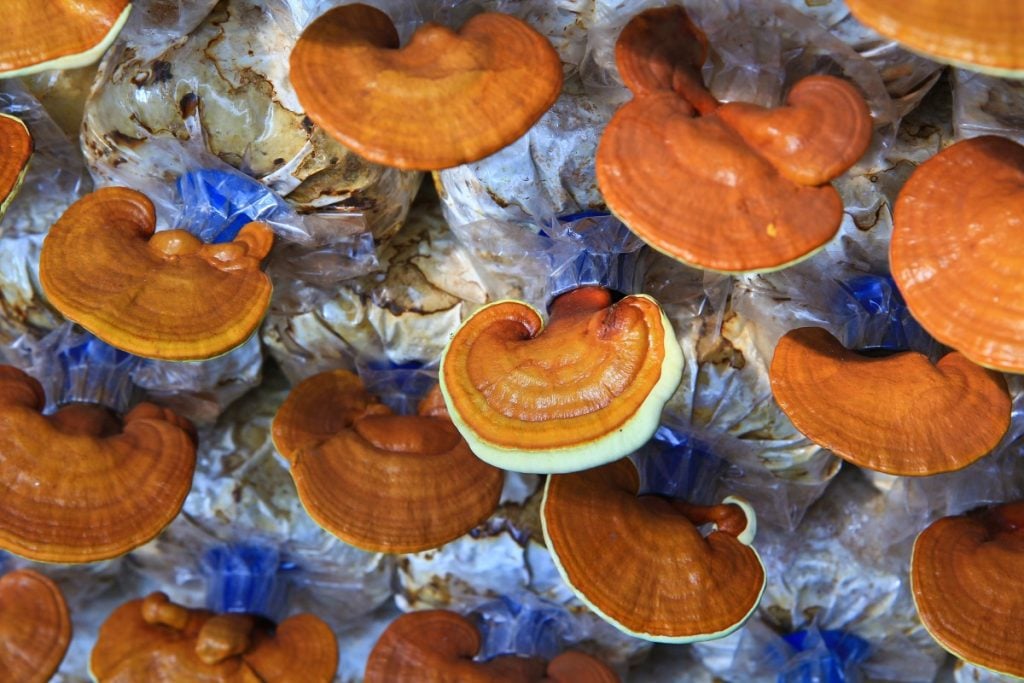
Growing Conk Reishi Mushrooms
When you expose reishi mushroom pins or antlers to oxygen-rich fresh air, they flatten out and form fan-like conks at the end of the antlers.
These conks are the shiny red, spore-producing fruiting bodies of the reishi fungus.
To grow reishi conks, first, allow antlers to form inside your closed grow bag. Then, when the antlers are 2-3 inches (5-8cm) tall, cut open the top of the bag and place it in fruiting conditions.
Reishi needs a location with room temperatures, high humidity, indirect light and good airflow for fruiting.
It will take anywhere from 30 to 45 days for your reishi to mature and form full conks.
Step 6: Harvesting
Reishi mushrooms grow a lot slower than many other types of mushrooms.
While some mushrooms, like oysters, can double in size daily and be ready for harvest in a week, reishi takes a lot longer.
If you are growing antler reishi, you can choose when to harvest them.
Harvest when the antlers are only a few inches tall, or allow them to grow for months and enjoy the unique shapes that develop.
Growing reishi conks will give you a higher yield. You can also harvest reishi conks at any stage. But, to get the best yield, aim to harvest them just before they drop their spores.
While they’re growing, reishi mushrooms have a bright white leading edge. When this edge begins to get smaller, it’s a sign they’re almost finished growing and the best time to harvest them.
At this stage of maturity, they should be fan-shaped with a reddish color and a wet lacquered appearance.
Reishi mushrooms have a heavy spore load, so you want to harvest them before they cover the area around them in brown dust.
Use a sharp blade or serrated knife to cut the mature Reishi mushrooms off the fruiting block. Be careful not to damage any mushrooms that are still growing.
How to Grow Reishi Mushrooms Outdoors on Logs
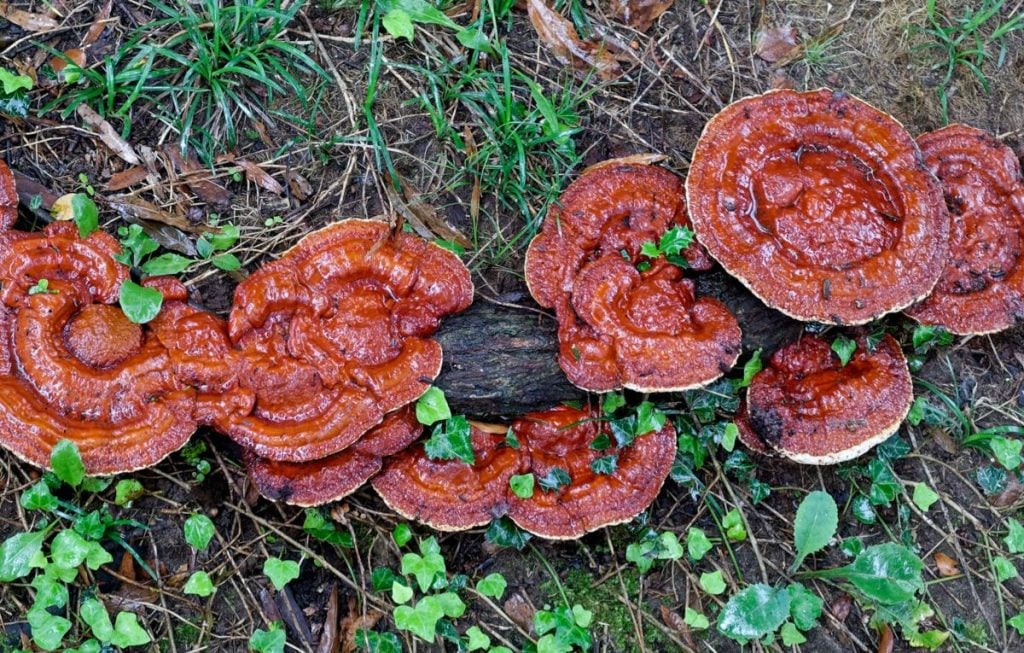
Growing reishi mushrooms outdoors on logs is the easiest way to grow reishi, but it takes longer and is less reliable than sawdust blocks.
However, reishi grown on logs will produce mushrooms for several years until they have used up all the nutrients in the logs.
You can use both plug or sawdust spawn to inoculate logs. But, plug spawn is a little easier for beginners.
In the step-by-step guide below, you’ll find everything you need to know to grow reishi mushrooms on logs using plug spawn.
Step 1: Gather Supplies
The first step in growing reishi on logs is to gather the materials and equipment needed, including finding suitable logs and ordering reishi spawn.
Select and Cut Logs
You can grow reishi mushrooms on logs from most broad-leaved hardwood trees, but some produce better yields than others.
Oak, sugar maple, beech and plumb are good choices and will give you high yields.
Cut logs with intact bark from healthy living hardwood trees, preferably while they’re dormant. Dormant trees are full of sap and have higher concentrations of nutrients and sugars.
Reishi mushrooms can be grown on logs of various diameters, including tree stumps, using both the drill and fill or totem methods.
A popular method of growing reishi in the Orient uses short logs 12 to 20 inches (30 to 50 cm) in length and 4 to 6 inches (10 to 15 cm) in diameter. These are then buried vertically into well-drained soil or plant pots.
Longer logs, around 3.5 feet (1 meter) in length, are often buried horizontally in the ground.
If you plan to use the drill and fill method, logs that are 4 inches (10 cm) in diameter and 36 to 40 inches (91 to 102 cm) in length are ideal.
But, as a standard, people use logs anywhere between 3 to 6 inches (8 to 15 cm) in diameter.
When to Cut Your Logs
There are two ideal times to cut logs. At these times, the sugary sap in the tree is most concentrated, and the bark is tight.
The first time is in the fall, after a third of the tree’s leaves have changed color. And the second, is late winter to early spring before the trees begin budding.
Ideally, aim to cut your logs 15 to 20 days before you plan on inoculating them.
Once cut, your logs need to rest for a minimum of two weeks before inoculation. To allow the tree’s defense system to stop working.
During this time, store them close to the ground, in a shady, sheltered spot to prevent them from drying out. But not on the ground, as lying on soil or a leaf layer could cause contamination.
You can rest your logs for more than two weeks but don’t wait more than a month before inoculating them.
Purchase Spawn
People usually use plug spawn for small projects of up to ten logs and it’s perfect for first-time reishi log growers.
You can buy reishi plug spawn online from several suppliers in bags of 100, 500 or 1000 plugs.
Before buying your plugs, you’ll need to calculate how many you need. A 36 to 40 inch (91 to 102 cm) log usually requires about 30 to 50 plugs for full coverage.
But, for accuracy, you can use this formula to figure out how many plugs you’ll need for any given log:
Number of holes = (Length of the log in cm x diameter of the log in cm) / 60
Once you have your logs and spawn plugs, gather the equipment needed for inoculation:
-
- A drill
-
- A hammer
-
- Sealing wax
-
- A small paintbrush or baster
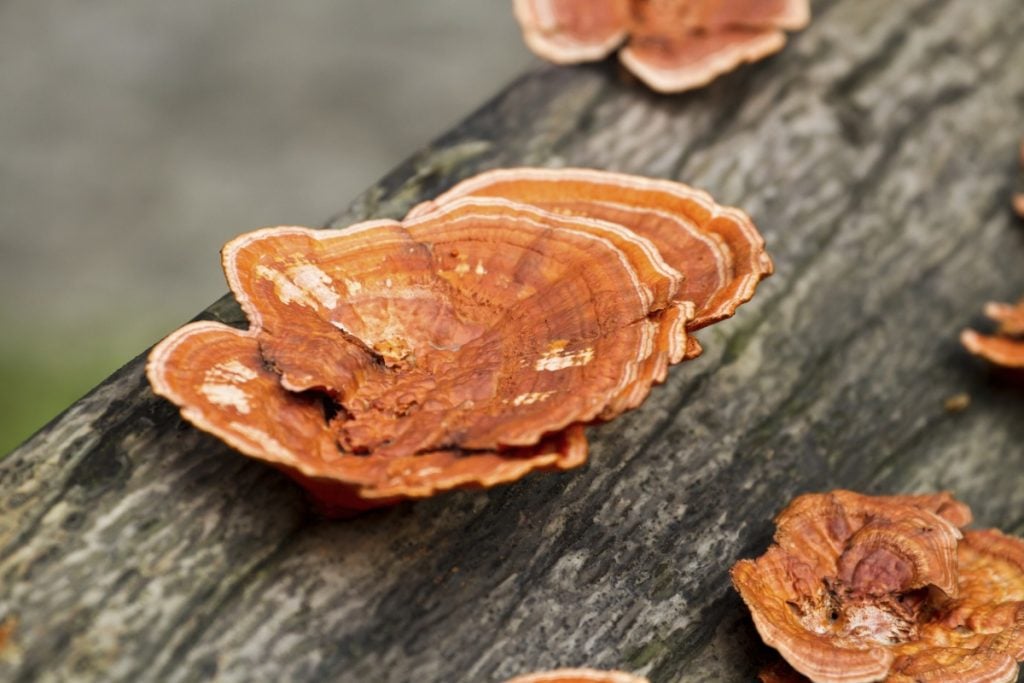
Step 2: Inoculation
The first step when inoculating logs with plug spawn is to drill holes.
Start by drilling a row of 1 inch (3cm) deep holes every 4 to 6 inches (10 to 15cm) apart down the length of your log.
Rotate the log and begin your next row 2 to 2.5 inches (5 to 6 cm) away from the first row, staggering the holes to create a diamond pattern.
When you have holes all the way around the log, insert a plug spawn dowel into each hole. Tap the dowels gently with a hammer until they are flush with the wood and slightly below the bark.
Now, you need to seal the plugged holes with wax to keep the mycelium from drying out and ensure no other fungi get into the log.
You can use cheese wax, candle wax or beeswax to do this. First, melt your wax in a double boiler or old pot, and then apply the wax to your holes using a small brush or wax dauber.
Step 3: Incubation
Once inoculated, place your logs in a shady, protected area where they can receive natural rainfall.
During incubation, maintaining the logs’ moisture levels is critical. If they dry out completely, your mycelium will die.
Your logs need around 1 inch ( 25mm) of rain a week. In dry spells, water your logs once or twice a week to maintain the correct moisture levels.
Logs inoculated in early spring could produce mushrooms by fall. But, it usually takes 12 months or more for reishi to fully colonize logs, depending on the size of the log and weather conditions.
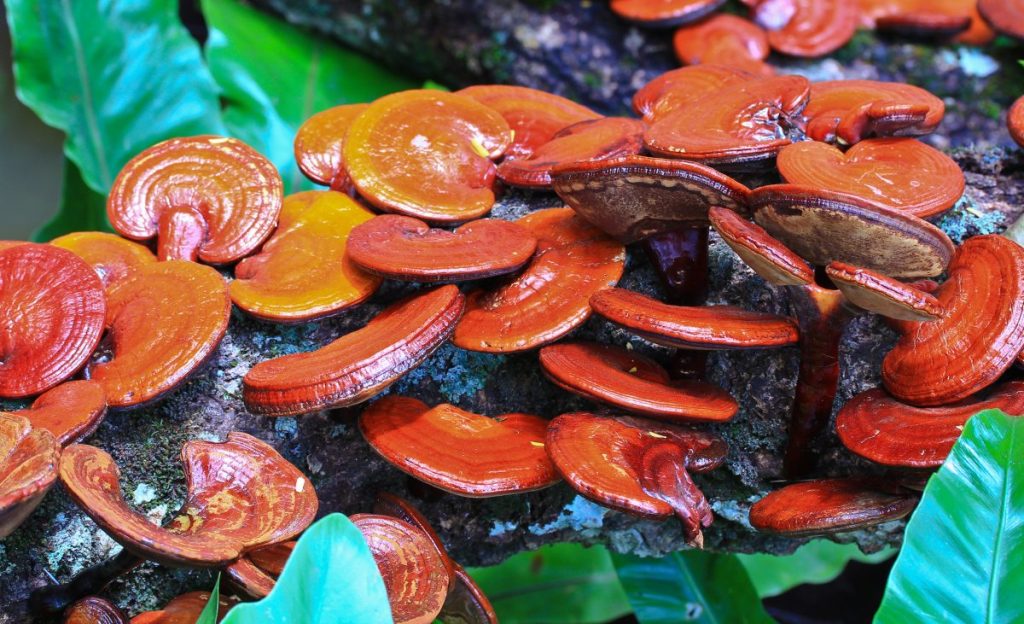
Step 4: Fruiting
Reishi mushrooms grow best in warm, humid conditions and will typically begin to form in the summer a year after inoculation.
Reishi tends to provide higher yields when you bury fully colonized logs in well-drained sandy soil and cover them with 2 inches (5cm) of topsoil.
Burying the logs helps maintain moisture levels and may also provide extra nutrients for the mycelium.
Mushrooms will fruit from the logs, and antler reishi will emerge through the topsoil into the fresh air and begin to flatten into conks.
It’s important to keep high humidity levels during fruiting, and if you live in a windy, dry area, it’s probably best to fruit your reishi in a greenhouse.
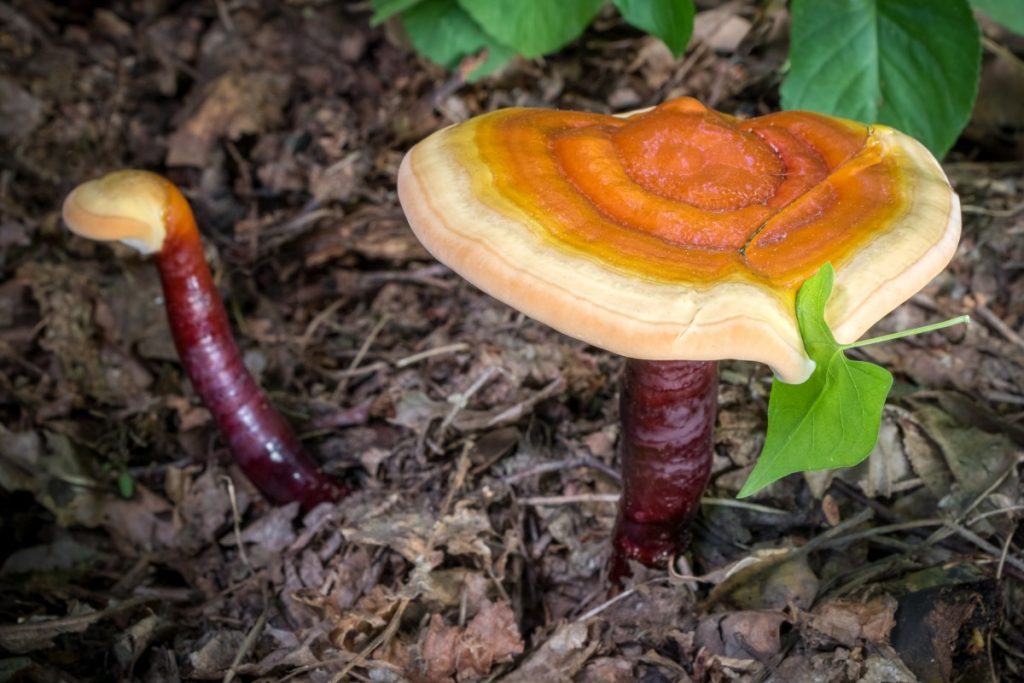
Step 5: Harvesting
You can harvest reishi at any stage, but if you’re patient and wait for them to mature, you’ll get a higher yield.
To harvest reishi, cut them at the base of the stem where they’re attached to the log with a sharp knife, pair of garden scissors or pruning shears.
How to Grow Reishi Mushrooms Outdoors Using Bags of Sawdust Substrate
This method of growing reishi outdoors is easy, much quicker than traditional log cultivation and fun.
It involves taking a fully colonized sawdust fruiting block and burying it in the ground to fruit.
Step 1: Make a Reishi Mushroom Fruiting Block
To make a colonized mushroom fruiting block, follow steps one to four in the step-by-step guide above for growing reishi indoors.
When fully colonized, little fruiting bodies called antlers will start to grow inside the bag.
Now it’s time to take your reishi fruiting block outdoors and “plant it.”
Step 2: Plant Your Reishi Fruiting Block
You can plant your fruiting block directly in the ground or in a raised bed or plant box.
Reishi needs indirect light, warmth and humidity to grow. If your reishi antlers dry out, they will stop growing.
If you don’t have a warm, shady, sheltered location in your garden, you’ll need to cover the reishi with something and create a mini greenhouse to prevent the sun and wind from drying them out.
Once you have chosen a location, take your fruiting block out of the bag, dig a hole and place the block in the soil, covering the top with a thin layer of soil.
The soil helps retain moisture but is not required to grow the reishi as all the nutrients the reishi needs are already contained in the hardwood sawdust block. But, the mycelia may also take some nutrients from the soil.
Once your reishi block is “planted,” give the ground a good soak with a hose to make sure there is enough moisture.
Step 3: Fruiting
The pins that started growing on the block while in the bag may die back. But, about a week after you plant the reishi block, you should see new pins starting to grow.
Humidity levels are critical when growing mushrooms, especially in the early stages when the pins form.
We suggest misting your reishi daily with a spray bottle at this stage to ensure they stay moist.
Your reishi will continue to grow and flatten out into mature shiny red fruiting bodies and could be ready for harvest in around six weeks.
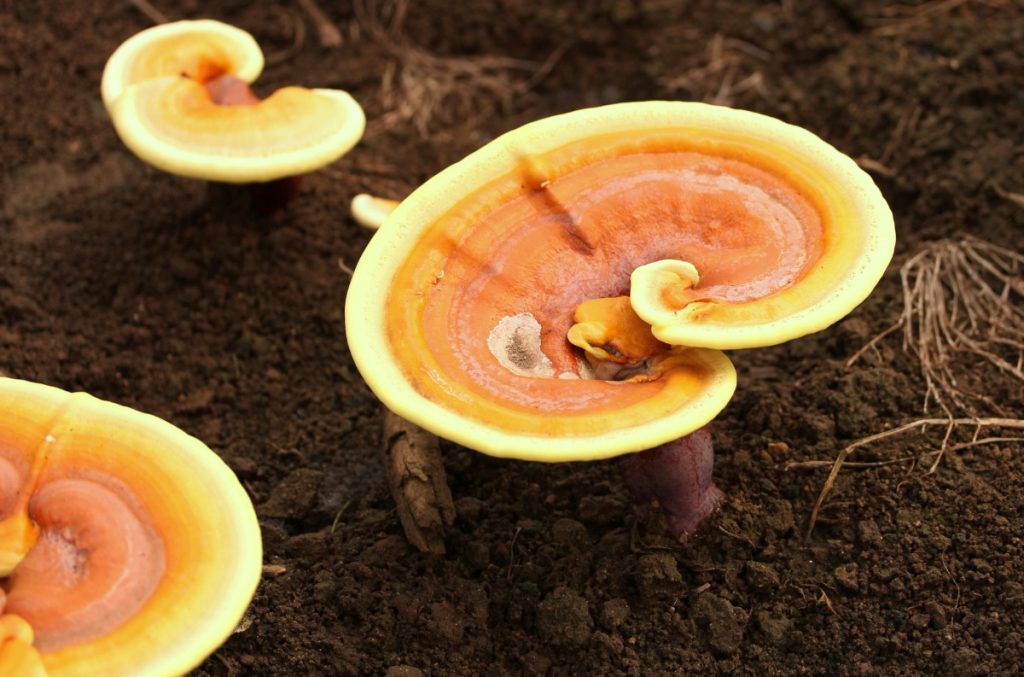
Step 4: Harvesting
You can harvest your reishi at any stage during their growth, but it’s best to harvest mature reishi just before they drop their spores.
Try to get as close to the block as possible, and using a sharp blade or serrated knife, cut the reishi off the fruiting block.
When to Plant Reishi Mushrooms
If you’re growing reishi outdoors on logs, the best time to plant them is in spring, but you can plant throughout the summer.
If you’re growing reishi outdoors using a fruiting block, you can plant throughout spring and summer, bearing in mind that reishi grows best when temperatures are 75 to 85F (24 to 29C).
Outdoors, reishi fruit in early to mid-summer, and you may need to protect the mushroom pins if you have a late cold spell.
When growing reishi mushrooms indoors in controlled conditions, you can grow them year-round.
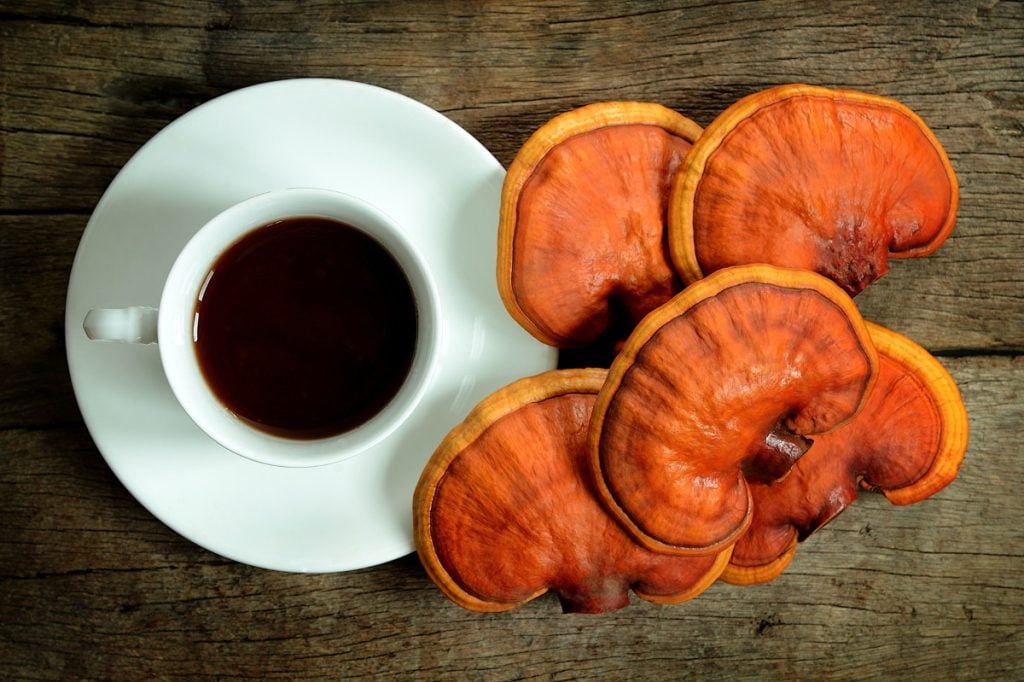
How to Use Reishi Mushrooms
Traditionally Reishi mushrooms were used fresh or dried in teas and soups.
Now they’re commonly consumed as a powder or made into teas and tinctures.
Try adding reishi powder to smoothies, soups and stews, but if you find the taste too bitter, taking reishi powder capsules may be better.
Making teas and tinctures is an excellent way to extract the medicinal compounds from reishi and access all their health benefits.
But, it takes time to make reishi tea, and the finished product is bitter and not all that enjoyable to drink.
Many people find a couple of drops of mushroom tincture the easiest way to get their daily dose of reishi.
Watch our medicinal mushrooms tinctures video to learn how to make a mushroom tincture from your reishi mushrooms.
Final Thoughts
Reishi is one of the most popular medicinal mushrooms and offers numerous health benefits.
They’re a good choice for home cultivation and fascinating to watch while they grow.
Now that you have more information on how to grow your own reishi mushrooms, we hope you’ll choose a method and get started.
If you also want to try the subtle flavors of edible mushrooms, visit our Mushroom Growing Hub.
Here you’ll find detailed guides and step-by-step instructions for growing several types of edible mushrooms.
